西安电子科技大学:《纠错码》课程教学资源(课件讲义)Cyclic Codes

Cyclic Codes Yunghsiang S.Han(韩永祥) School of Electrical Engineering Intelligentization Dongguan University of Technology(东莞理工学院) China E-mail:yunghsiangh@gmail.com
Cyclic Codes Yunghsiang S. Han (韩永祥) School of Electrical Engineering & Intelligentization Dongguan University of Technology (东莞理工学院) China E-mail: yunghsiangh@gmail.com
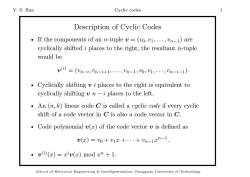
Y.S.Han Cyclic codes Description of Cyclic Codes If the components of an n-tuple v=(vo,v1,...,Un-1)are cyclically shifted i places to the right,the resultant n-tuple would be v)=(n-i,vn-i+1,,vn-l,0,U1,,n-i-1). Cyclically shifting v i places to the right is equivalent to cyclically shifting v n-i places to the left. An (n,k)linear code C is called a cyclic code if every cyclic shift of a code vector in C is also a code vector in C. Code polynomial v(x)of the code vector v is defined as u(x)=0+U1x+…+n-1xn-1. ·v((c)=xv(x))mod zm+1. School of Electrical Engineering Intelligentization,Dongguan University of Technology
Y. S. Han Cyclic codes 1 Description of Cyclic Codes • If the components of an n-tuple v = (v0, v1, . . . , vn−1) are cyclically shifted i places to the right, the resultant n-tuple would be v (i) = (vn−i , vn−i+1, . . . , vn−1, v0, v1, . . . , vn−i−1). • Cyclically shifting v i places to the right is equivalent to cyclically shifting v n − i places to the left. • An (n, k) linear code C is called a cyclic code if every cyclic shift of a code vector in C is also a code vector in C. • Code polynomial v(x) of the code vector v is defined as v(x) = v0 + v1 x + · · · + vn−1 x n−1 . • v (i) (x) = x i v(x) mod x n + 1. School of Electrical Engineering & Intelligentization, Dongguan University of Technology
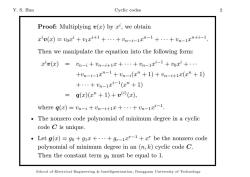
Y.S.Han Cyclic codes 2 Proof:Multiplying v(x)by x,we obtain x2v()=0x2+v1x+1+…+n--1xn-1++un-1an+i-1. Then we manipulate the equation into the following form: x2v(x)=n-i+n-i+1x+…+n-1xi-1+0x2+. +n-i-1xn-1+vn-i(xn+1)+wn-i+1x(x”+1) +…+vn-1x2-1(xn+1) =q(x)(xn+1)+v@(c), Where q(x)=Un-i+Un-i+1x+...+Un-1xi-1, The nonzero code polynomial of minimum degree in a cyclic code C is unique. Let g(x)=go+gx+...+gr-1x"-1+z"be the nonzero code polynomial of minimum degree in an (n,k)cyclic code C. Then the constant term go must be equal to 1. School of Electrical Engineering Intelligentization,Dongguan University of Technology
Y. S. Han Cyclic codes 2 Proof: Multiplying v(x) by x i , we obtain x i v(x) = v0 x i + v1 x i+1 + · · · + vn−i−1 x n−1 + · · · + vn−1 x n+i−1 . Then we manipulate the equation into the following form: x i v(x) = vn−i + vn−i+1x + · · · + vn−1 x i−1 + v0 x i + · · · +vn−i−1 x n−1 + vn−i (x n + 1) + vn−i+1x(x n + 1) + · · · + vn−1 x i−1 (x n + 1) = q(x)(x n + 1) + v (i) (x), where q(x) = vn−i + vn−i+1x + · · · + vn−1 x i−1 . • The nonzero code polynomial of minimum degree in a cyclic code C is unique. • Let g(x) = g0 + g1 x + · · · + gr−1 x r−1 + x r be the nonzero code polynomial of minimum degree in an (n, k) cyclic code C. Then the constant term g0 must be equal to 1. School of Electrical Engineering & Intelligentization, Dongguan University of Technology
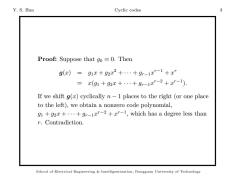
Y.S.Han Cyclic codes Proof:Suppose that go =0.Then 9(x)=91x+92x2+·+9,-1x-1+x =x(g1+92x+…+9-1x-2+x-1). If we shift g(x)cyclically n-1 places to the right (or one place to the left),we obtain a nonzero code polynomial, g1+g2+...+gr-x"-2+x"-1,which has a degree less than r.Contradiction. School of Electrical Engineering Intelligentization,Dongguan University of Technology
Y. S. Han Cyclic codes 3 Proof: Suppose that g0 = 0. Then g(x) = g1 x + g2 x 2 + · · · + gr−1 x r−1 + x r = x(g1 + g2 x + · · · + gr−1 x r−2 + x r−1 ). If we shift g(x) cyclically n − 1 places to the right (or one place to the left), we obtain a nonzero code polynomial, g1 + g2 x + · · · + gr−1 x r−2 + x r−1 , which has a degree less than r. Contradiction. School of Electrical Engineering & Intelligentization, Dongguan University of Technology
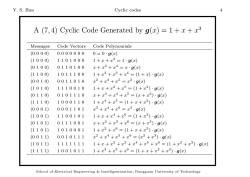
Y.S.Han Cyclic codes A (7,4)Cyclic Code Generated by g(x)=1+x+23 Messages Code Vectors Code Polynomials (0000) 00000000=0·g(x) (1000) 11010001+x+x3=1·g(x) (0100) 0110100x+x2+x4=x·g(x) (1100) 1011100 1+x2+x3+x4=(1+x)·g(x) (0010) 0011010 x2+x3+x5=x2·g(c) (1010) 1110010 1+x+x2+x5=(1+x2)·9(x) (0110) 0101110 x+x3+x4+x5=(x+x2)·g(x) (1110) 1000110 1+x4+x5=(1+x+x2)·g(x) (0001) 0001101 x3+x4+x6=x3·g(c) (1001) 11001011+x+x4+x6=(1+x3)·g(x) (0101) 0111001 x+x2+x3+x6=(x+x3)·g(x) (1101) 1010001 1+x2+x6=(1+x+x3)·g(x) (0011) 0010111x2+x4+x5+x6=(x2+x3)·g(x) (1011) 1111111 1+x+x2+x3+x4+x5+x6=(1+x2+x3)·g(x) (1111) 1001011 1+x3+x5+x6=(1+x+x2+x3)·g(c) School of Electrical Engineering Intelligentization,Dongguan University of Technology
Y. S. Han Cyclic codes 4 A (7, 4) Cyclic Code Generated by g(x) = 1 + x + x 3 Messages Code Vectors Code Polynomials (0 0 0 0) 0 0 0 0 0 0 0 0 = 0 · g(x) (1 0 0 0) 1 1 0 1 0 0 0 1 + x + x 3 = 1 · g(x) (0 1 0 0) 0 1 1 0 1 0 0 x + x 2 + x 4 = x · g(x) (1 1 0 0) 1 0 1 1 1 0 0 1 + x 2 + x 3 + x 4 = (1 + x) · g(x) (0 0 1 0) 0 0 1 1 0 1 0 x 2 + x 3 + x 5 = x 2 · g(x) (1 0 1 0) 1 1 1 0 0 1 0 1 + x + x 2 + x 5 = (1 + x 2 ) · g(x) (0 1 1 0) 0 1 0 1 1 1 0 x + x 3 + x 4 + x 5 = (x + x 2 ) · g(x) (1 1 1 0) 1 0 0 0 1 1 0 1 + x 4 + x 5 = (1 + x + x 2 ) · g(x) (0 0 0 1) 0 0 0 1 1 0 1 x 3 + x 4 + x 6 = x 3 · g(x) (1 0 0 1) 1 1 0 0 1 0 1 1 + x + x 4 + x 6 = (1 + x 3 ) · g(x) (0 1 0 1) 0 1 1 1 0 0 1 x + x 2 + x 3 + x 6 = (x + x 3 ) · g(x) (1 1 0 1) 1 0 1 0 0 0 1 1 + x 2 + x 6 = (1 + x + x 3 ) · g(x) (0 0 1 1) 0 0 1 0 1 1 1 x 2 + x 4 + x 5 + x 6 = (x 2 + x 3 ) · g(x) (1 0 1 1) 1 1 1 1 1 1 1 1 + x + x 2 + x 3 + x 4 + x 5 + x 6 = (1 + x 2 + x 3 ) · g(x) (1 1 1 1) 1 0 0 1 0 1 1 1 + x 3 + x 5 + x 6 = (1 + x + x 2 + x 3 ) · g(x) School of Electrical Engineering & Intelligentization, Dongguan University of Technology
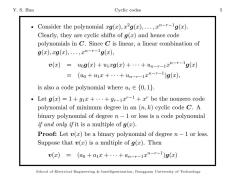
Y.S.Han Cyclic codes Consider the polynomial xg(x),22g(x),...,xm--1g(x). Clearly,they are cyclic shifts of g(x)and hence code polynomials in C.Since C is linear,a linear combination of g(x),xg(x),...,xn-r-1g(x), v(x)=uog(r)+u1xg()+…+n-r-1an-r-1g(x) =(o+w1x+·+n-r-1xn-T-1)g(x), is also a code polynomial where ui∈{0,l}. Let g(z)=1+gx+...+gr-1x"-1+x"be the nonzero code polynomial of minimum degree in an (n,k)cyclic code C.A binary polynomial of degree n-1 or less is a code polynomial if and only if it is a multiple of g(x). Proof:Let v(x)be a binary polynomial of degree n-1 or less. Suppose that v(x)is a multiple of g(x).Then v(x)=(ao+az+...+an-r-1x"-r-1)g(x) School of Electrical Engineering Intelligentization,Dongguan University of Technology
Y. S. Han Cyclic codes 5 • Consider the polynomial xg(x), x2 g(x), . . . , xn−r−1 g(x). Clearly, they are cyclic shifts of g(x) and hence code polynomials in C. Since C is linear, a linear combination of g(x), xg(x), . . . , xn−r−1 g(x), v(x) = u0 g(x) + u1 xg(x) + · · · + un−r−1 x n−r−1 g(x) = (u0 + u1 x + · · · + un−r−1 x n−r−1 )g(x), is also a code polynomial where ui ∈ {0, 1}. • Let g(x) = 1 + g1 x + · · · + gr−1 x r−1 + x r be the nonzero code polynomial of minimum degree in an (n, k) cyclic code C. A binary polynomial of degree n − 1 or less is a code polynomial if and only if it is a multiple of g(x). Proof: Let v(x) be a binary polynomial of degree n − 1 or less. Suppose that v(x) is a multiple of g(x). Then v(x) = (a0 + a1 x + · · · + an−r−1 x n−r−1 )g(x) School of Electrical Engineering & Intelligentization, Dongguan University of Technology
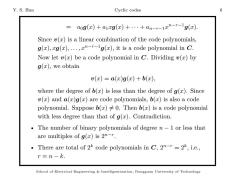
Y.S.Han Cyclic codes 6 aog(x)+axg(x)+...+an-r-1x"-r-1g(x). Since v(x)is a linear combination of the code polynomials, g(x),xg(x),...,"--1g(x),it is a code polynomial in C. Now let v(x)be a code polynomial in C.Dividing v(x)by g(x),we obtain v(x)=a(x)g(z)+b(x), where the degree of b(x)is less than the degree of g(z).Since v(x)and a(x)g(x)are code polynomials,b(x)is also a code polynomial.Suppose b(x)0.Then b(x)is a code polynomial with less degree than that of g(x).Contradiction. The number of binary polynomials of degree n-1 or less that are multiples of g(x)is 2m-r. There are total of 2 code polynomials in C,2"-=2%,i.e., r=n-k. School of Electrical Engineering Intelligentization,Dongguan University of Technology
Y. S. Han Cyclic codes 6 = a0 g(x) + a1 xg(x) + · · · + an−r−1 x n−r−1 g(x). Since v(x) is a linear combination of the code polynomials, g(x), xg(x), . . . , xn−r−1 g(x), it is a code polynomial in C. Now let v(x) be a code polynomial in C. Dividing v(x) by g(x), we obtain v(x) = a(x)g(x) + b(x), where the degree of b(x) is less than the degree of g(x). Since v(x) and a(x)g(x) are code polynomials, b(x) is also a code polynomial. Suppose b(x) ̸= 0. Then b(x) is a code polynomial with less degree than that of g(x). Contradiction. • The number of binary polynomials of degree n − 1 or less that are multiples of g(x) is 2 n−r . • There are total of 2 k code polynomials in C, 2 n−r = 2k , i.e., r = n − k. School of Electrical Engineering & Intelligentization, Dongguan University of Technology
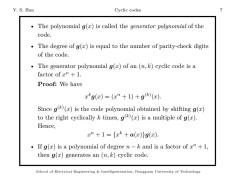
Y.S.Han Cyclic codes The polynomial g(x)is called the generator polynomial of the code. The degree of g(x)is equal to the number of parity-check digits of the code. The generator polynomial g(x)of an (n,k)cyclic code is a factor of x"+1. Proof:We have xg(x)=(n+1)+g(c). Since g(k)()is the code polynomial obtained by shifting g(x) to the right cyclically k times,g()is a multiple of g(). Hence, 2n+1={xk+a(x)}g(z). If g(x)is a polynomial of degree n-k and is a factor of x"+1, then g(x)generates an (n,k)cyclic code. School of Electrical Engineering Intelligentization,Dongguan University of Technology
Y. S. Han Cyclic codes 7 • The polynomial g(x) is called the generator polynomial of the code. • The degree of g(x) is equal to the number of parity-check digits of the code. • The generator polynomial g(x) of an (n, k) cyclic code is a factor of x n + 1. Proof: We have x k g(x) = (x n + 1) + g (k) (x). Since g (k) (x) is the code polynomial obtained by shifting g(x) to the right cyclically k times, g (k) (x) is a multiple of g(x). Hence, x n + 1 = {x k + a(x)}g(x). • If g(x) is a polynomial of degree n − k and is a factor of x n + 1, then g(x) generates an (n, k) cyclic code. School of Electrical Engineering & Intelligentization, Dongguan University of Technology
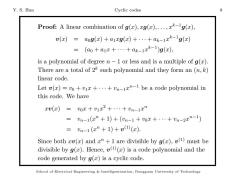
Y.S.Han Cyclic codes 8 Proof:A linear combination of g(),xg(a),...g(), v(x)=aog(x)+alzg(x)+...+ak-1xk-1g(z) =(a0+a1x+·+ak-1x-1)g(x), is a polynomial of degree n-1 or less and is a multiple of g(x). There are a total of 2%such polynomial and they form an (n,k) linear code. Let v(x)=vo +v12+...+Un-1x"-1 be a code polynomial in this code.We have xv(c)=0x+u1x2+…+n-1x” =vn-1(x”+1)+(n-1+0x+…+vn-2xn-1) =vn-1(xn+1)+v1(c). Since both xu(x)and x"+1 are divisible by g(a),v(1)must be divisible by g().Hence,v(1)(x)is a code polynomial and the code generated by g()is a cyclic code. School of Electrical Engineering Intelligentization,Dongguan University of Technology
Y. S. Han Cyclic codes 8 Proof: A linear combination of g(x), xg(x), . . . , xk−1 g(x), v(x) = a0 g(x) + a1 xg(x) + · · · + ak−1 x k−1 g(x) = (a0 + a1 x + · · · + ak−1 x k−1 )g(x), is a polynomial of degree n − 1 or less and is a multiple of g(x). There are a total of 2 k such polynomial and they form an (n, k) linear code. Let v(x) = v0 + v1 x + · · · + vn−1 x n−1 be a code polynomial in this code. We have xv(x) = v0 x + v1 x 2 + · · · + vn−1 x n = vn−1(x n + 1) + (vn−1 + v0 x + · · · + vn−2 x n−1 ) = vn−1 (x n + 1) + v (1)(x). Since both xv(x) and x n + 1 are divisible by g(x), v (1) must be divisible by g(x). Hence, v (1)(x) is a code polynomial and the code generated by g(x) is a cyclic code. School of Electrical Engineering & Intelligentization, Dongguan University of Technology
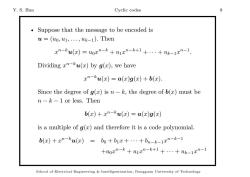
Y.S.Han Cyclic codes Suppose that the message to be encoded is u=(uo,u1,...,uk-1).Then xn-ku(c)=uoxn-k+u1xn-k+1+…十uk-1xn-1. Dividing z-ku(x)by g(x),we have x"-ku(x)=a(x)g(z)+b(x). Since the degree of g(x)is n-k,the degree of b(x)must be n-k-1 or less.Then b(x)+x"-ku(x)=a(x)g(x) is a multiple of g(x)and therefore it is a code polynomial. b(c)+xn-u(c)=b0+b1x+…+bn-k-1xn-k-1 +uoxn-k+u1x”-k+1+…+-1xn-1 School of Electrical Engineering Intelligentization,Dongguan University of Technology
Y. S. Han Cyclic codes 9 • Suppose that the message to be encoded is u = (u0, u1, . . . , uk−1). Then x n−k u(x) = u0 x n−k + u1 x n−k+1 + · · · + uk−1 x n−1 . Dividing x n−k u(x) by g(x), we have x n−k u(x) = a(x)g(x) + b(x). Since the degree of g(x) is n − k, the degree of b(x) must be n − k − 1 or less. Then b(x) + x n−k u(x) = a(x)g(x) is a multiple of g(x) and therefore it is a code polynomial. b(x) + x n−k u(x) = b0 + b1 x + · · · + bn−k−1 x n−k−1 +u0 x n−k + u1 x n−k+1 + · · · + uk−1 x n−1 School of Electrical Engineering & Intelligentization, Dongguan University of Technology
按次数下载不扣除下载券;
注册用户24小时内重复下载只扣除一次;
顺序:VIP每日次数-->可用次数-->下载券;
- 西安电子科技大学:《纠错码》课程教学资源(课件讲义)Decoding BCH/RS Codes.pdf
- 西安电子科技大学:《纠错码》课程教学资源(课件讲义)BCH Codes.pdf
- 西安电子科技大学:《纠错码》课程教学资源(课件讲义)Introduction to Finite Fields.pdf
- 西安电子科技大学:《信息论与编码理论基础》课程PPT教学课件(信息论)第九章 率失真函数.ppt
- 西安电子科技大学:《信息论与编码理论基础》课程PPT教学课件(编码部分)卷积码.pptx
- 西安电子科技大学:《信息论与编码理论基础》课程PPT教学课件(编码部分)循环码.pptx
- 西安电子科技大学:《信息论与编码理论基础》课程PPT教学课件(编码部分)有限域.ppt
- 西安电子科技大学:《信息论与编码理论基础》课程PPT教学课件(编码部分)线性分组码.pptx
- 西安电子科技大学:《信息论与编码理论基础》课程PPT教学课件(编码部分)码纠错能力的判断.ppt
- 西安电子科技大学:《信息论与编码理论基础》课程PPT教学课件(信息论)第五章 信道编码定理.ppt
- 西安电子科技大学:《信息论与编码理论基础》课程PPT教学课件(信息论)第四章 信道及其容量.ppt
- 西安电子科技大学:《信息论与编码理论基础》课程PPT教学课件(信息论)第三章 信源编码(一)离散信源无失真编码.ppt
- 西安电子科技大学:《信息论与编码理论基础》课程PPT教学课件(信息论)第二章 信息量和熵.ppt
- 西安电子科技大学:《信息论与编码理论基础》课程PPT教学课件(信息论)第一章 引论(主讲:孙蓉).ppt
- 西安电子科技大学:《纠错码与差错控制》课程教学资源(PPT课件)第四章 多项式环与有限域.ppt
- 西安电子科技大学:《纠错码与差错控制》课程教学资源(PPT课件)第三章 线性分组码.ppt
- 西安电子科技大学:《纠错码与差错控制》课程教学资源(PPT课件)第二部分 代数引论.ppt
- 西安电子科技大学:《纠错码与差错控制》课程教学资源(PPT课件)第一章 纠错码基本概念(主讲:孙蓉).ppt
- 安徽科技学院:《电子技术》课程教学资源(PPT课件)第二章 基本放大电路.ppt
- 安徽科技学院:《电子技术》课程教学资源(PPT课件)第三章 集成运算放大器.ppt
- 西安电子科技大学:《纠错码》课程教学资源(课件讲义)Introduction to Binary Linear Block Codes(主讲:韩永祥).pdf
- 西安电子科技大学:《纠错码》课程教学资源(课件讲义)Introduction to Reed-Solomon Codes[.pdf
- 西安电子科技大学:《通信原理》课程教学资源(课件讲稿)第1章 绪论(主讲:刘龙伟).pdf
- 西安电子科技大学:《通信原理》课程教学资源(课件讲稿)第2章 随机过程.pdf
- 西安电子科技大学:《通信原理》课程教学资源(课件讲稿)第3章 信道与噪声.pdf
- 西安电子科技大学:《通信原理》课程教学资源(课件讲稿)第4章 模拟通信系统.pdf
- 西安电子科技大学:《通信原理》课程教学资源(课件讲稿)第5章 数字基带传输系统.pdf
- 西安电子科技大学:《通信原理》课程教学资源(课件讲稿)第6章 模拟信号的数字传输(1/3)6.1 抽样定理 超链接 6.2 脉冲幅度调制(PAM)超链接.pdf
- 西安电子科技大学:《通信原理》课程教学资源(课件讲稿)第6章 模拟信号的数字传输(2/3)6.3 脉冲编码调制(PCM).pdf
- 西安电子科技大学:《通信原理》课程教学资源(课件讲稿)第6章 模拟信号的数字传输(3/3)6.4 自适应差分脉冲编码调制 6.5 增量调制(△M)6.6 时分复用(TDM).pdf
- 西安电子科技大学:《通信原理》课程教学资源(课件讲稿)第7章 数字频带传输系统.pdf
- 西安电子科技大学:《通信原理》课程教学资源(课件讲稿)第10章 复用和数字复接技术.pdf
- 西安电子科技大学:《通信原理》课程教学资源(课件讲稿)第11章 同步技术.pdf
- 西安电子科技大学:《通信原理》课程教学资源(课件讲稿)第8章 数字信号的最佳接收.pdf
- 西安电子科技大学:《通信原理》课程教学资源(课件讲稿)第9章 现代数字调制解调技术.pdf
- 西安电子科技大学:《通信原理》课程教学资源(辅导资料)ISI.ppt
- 西安电子科技大学:《通信原理》课程教学资源(辅导资料)Viterbi译码.ppt
- 《通信原理》课程教学资源(辅导资料)Selected MIMO Techniques and their Performance.pdf
- 西安电子科技大学:《信号检测与估值》课程教学资源(课件讲稿,2019)第一章 高斯信道上的信号检测.pdf
- 西安电子科技大学:《信号检测与估值》课程教学资源(课件讲稿,2019)第二章 衰落信道上的信号检测.pdf
